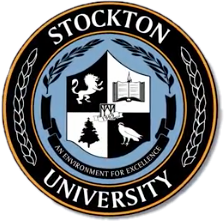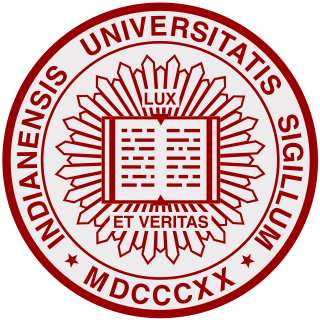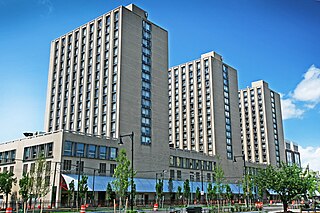The Patrick and Margaret DeNaples Center is The University of Scranton's campus center. On January 31, 2006, the University announced plans for the DeNaples Center, a new $30,000,000 campus center that would replace Gunster Memorial Student Center and mark the University’s most ambitious project in its 118-year history. [1] In the four decades since Gunster had been constructed in 1960, the University of Scranton, as University President Father Pilarz said, “has evolved into a broadly regional, comprehensive institution with students coming from more than 30 states and more than 35 countries," and thus “has simply outgrown the 77,000 square foot Gunster Center, which was built for a time when only 228 of our total student enrollment of 2,300 lived on campus.” [2]
Rev. Scott R. Pilarz, S.J., is a Jesuit priest, academic and the current 26th president of the University of Scranton. Previously serving as Scranton's 24th President from 2003-2011, Pilarz was announced as the successor of Kevin Quinn on March 21, 2017. Prior to returning to Scranton, Pilarz served as the President of the Marquette University and Georgetown Prep.
The DeNaples Center is a four-story building located on the 900 block of Mulberry Street in Scranton, Pennsylvania. The first floor of the building includes a grand lobby, the campus bookstore, the student mail center, commuter lockers, a Provisions on Demand (P.O.D.) convenience and the DeNaples Food Court, a retail dining option with seating for 250, which includes Starbucks Coffee, Chick-Fil-A, and Quizno’s among other options. [2] The second floor offers a fireplace lounge, offices for Student Affairs, University Ministries and the Student Forum. [2] The Student Forum contains a computer lab for students to use, as well as student space with couches and tables. The Student Forum is home to the Center for Student Engagement, including the offices for the University of Scranton Programming Board (USPB), the Aquinas newspaper, the Windhover yearbook, the Jane Kopas Women's Center, the Multicultural Center, Student Government, and Community Outreach. [1] The third floor serves as the primary dining space in the building and has seating for 800. Run by ARAMARK’s “Fresh Food Company,” the third floor dining hall contains several different stations, including Southern Kitchen, a fresh produce market, a pasta station, a brick oven, Mediterranean deli, Brazilian grill, round grill and charbroiler, where all meals are made fresh to order. [3] The fourth floor includes a subdividable 7,000 sq. ft. ballroom with dinner seating for 425 and lecture seating for more than 700 and three multipurpose meeting rooms as well as the Ann and Leo Moscovitz Theater with 260 fixed seats which boasts high-definition video, surround sound and comfortable, oversized theater seating. [1] On September 13, 2009, the fourth floor ballroom was dedicated in honor of Rev. Bernard R. McIllhenny, S.J., who served as headmaster at Scranton Prep from 1958-1966 and dean of admissions at the University from 1966-1997. [4]

Pennsylvania, officially the Commonwealth of Pennsylvania, is a state located in the northeastern, Great Lakes and Mid-Atlantic regions of the United States. The Appalachian Mountains run through its middle. The Commonwealth is bordered by Delaware to the southeast, Maryland to the south, West Virginia to the southwest, Ohio to the west, Lake Erie and the Canadian province of Ontario to the northwest, New York to the north, and New Jersey to the east.

Starbucks Corporation is an American coffee company and coffeehouse chain. Starbucks was founded in Seattle, Washington in 1971. As of early 2019, the company operates over 30,000 locations worldwide.

Chick-fil-A is an American fast food restaurant chain headquartered in the city of College Park, Georgia, specializing in chicken sandwiches. Founded in May 1946, it operates more than 2,200 restaurants, primarily in the United States. The restaurant serves breakfast before transitioning to its lunch and dinner menu. Chick-fil-A also offers customers catered selections from its menu for special events.
The DeNaples Center was the first building on campus designed and constructed to achieve the LEED certification as part of the University’s Sustainability initiatives, which it received in February 2009. [3] LEED stands for Leadership in Energy and Environmental Design, a cutting-edge system for certifying design, construction and operations of “green” buildings, coordinated by the U.S. Green Building Council. [5] Some environmentally friendly highlights of the DeNaples Center include reduced light pollution, a drip irrigation system, and optimized energy performance. The building also features products with recycled content, daylight harvesting, occupancy sensors for lighting control, water-saving fixtures, and a kitchen ventilation system that monitors heat and smoke and will adjust ventilation requirements according to need and not merely according to building occupancy schedule. [5]

Leadership in Energy and Environmental Design (LEED) is one of the most popular green building certification programs used worldwide. Developed by the non-profit U.S. Green Building Council (USGBC) it includes a set of rating systems for the design, construction, operation, and maintenance of green buildings, homes, and neighborhoods that aims to help building owners and operators be environmentally responsible and use resources efficiently.

The U.S. Green Building Council (USGBC), co-founded by Mike Italiano, David Gottfried and Rick Fedrizzi in 1993, is a private 501(c)3, membership-based non-profit organization that promotes sustainability in building design, construction, and operation. USGBC is best known for its development of the Leadership in Energy and Environmental Design (LEED) green building rating systems and its annual Greenbuild International Conference and Expo, the world’s largest conference and expo dedicated to green building. USGBC was one of eight national councils that helped found the World Green Building Council (WorldGBC). The current president and CEO is Mahesh Ramanujam who acquired this role in January 2017 after co-founder Rick Fedrizzi.

Drip irrigation is a type of micro-irrigation system that has the potential to save water and nutrients by allowing water to drip slowly to the roots of plants, either from above the soil surface or buried below the surface. The goal is to place water directly into the root zone and minimize evaporation. Drip irrigation systems distribute water through a network of valves, pipes, tubing, and emitters. Depending on how well designed, installed, maintained, and operated it is, a drip irrigation system can be more efficient than other types of irrigation systems, such as surface irrigation or sprinkler irrigation.
The DeNaples Center is named in honor of the late Patrick and Margaret DeNaples, the parents of Louis DeNaples Sr., a local business owner, active community volunteer and philanthropist, former University board member, and reputed organized crime associate. [6] [7] The DeNaples Center was dedicated in February 2008. [8] Upon the completion and opening of the DeNaples Center, the Gunster Memorial Student Center was demolished and was replaced by the Dionne Green, a large green space located directly in front of the DeNaples Center. [9]
Louis DeNaples is a Scrantonian best known as owner of Keystone Landfill Inc. In January 2008, DeNaples was charged with four counts of perjury owing to his suspected ties to the Bufalino crime family when applying for a Pennsylvania state gambling license. The charges were later dropped in April 2009 after DeNaples agreed to turn over legal control of Mount Airy Casino resort to his family. DeNaples is owner of or invested in several businesses, including DeNaples Auto Parts, Inc., and is Chairman of the Board of First National Community Bankcorp, Inc.













